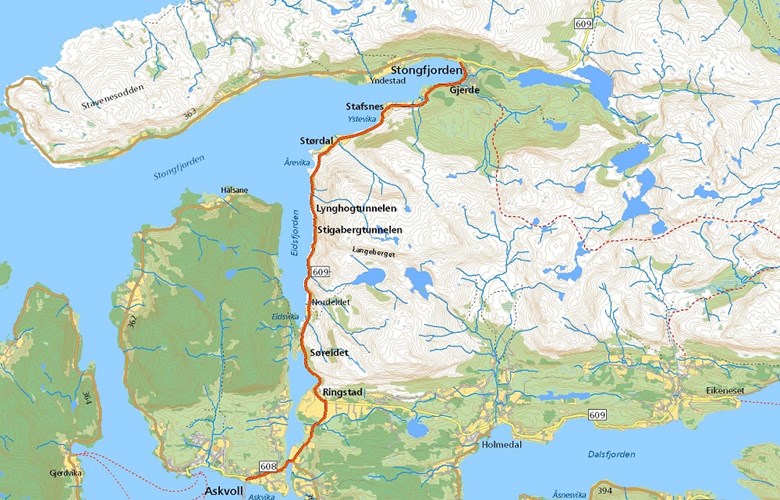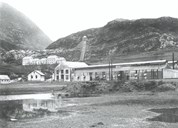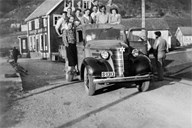Askvoll-Stongfjorden
The road Askvoll-Stongfjorden was planned in the latter part of the 1800s. In 1893, Askvoll received a grant from the county to rebuild the bridge of Strømsbrua at Askvoll, as a part of the whole project. The first part of the road Askvoll-Stongfjorden was in the road plan of 1907. In 1910, Askvoll asked that the project be given higher priority, since there was industrial activity at Stongfjorden. This made the road a necessity. But the county council found that the project could not be moved up on the list.
The project was given ordinary appropriations only in 1935-36. Stongfjorden (Gjerde)-Stafnes was built with emergency funds in 1921-22 and 1924-25, and was finished in 1927. In the late 1930s, Stafnes-Størdal was built. The section Størdal-Søreide was finished in 1947, and between Søreide and Ringstad improvements were being made at the same time. The road between Askvoll and Ringstad was old.
Activity during the war
During the Second World War, the Germans speeded up some important road projects. They were Totland-Måløy, Førde-Florø, Årdalstangen-Årdal. Some of the ordinary road projects were also partly under construction, such as Leikanger-Hella, Osen-Dale, Vetlefjorden-Tjugum, and Stongfjorden-Askvoll. During the war there was for a time tunnel work at Eidsfjorden. After a stop, work was started again in February of 1945, and the road between Stongfjorden and Askvoll was finished in 1946.


An "action-like" working day
Albert Nistad from Dale was in the autumn of 1944 doing masonry work a short distance to the north of the tunnel at Stegaberget at Eidsfjorden. He remembers that he one morning when he arrived at work, saw that a German convoy had taken shelter at Eidsfjorden. A short time before noon he heard the sound of aircraft engines, and he sought refuge in the tunnel. There was an inferno of shooting, he says, and there were as many as 37 planes in the air. One of the aircrafts was hit and was heading for the tunnel. It landed in the water below and exploded. The Germans disappeared, but more boats arrived later. One of the ships was bombed by an aircraft coming down along the mountainside. The ship went to pieces and sank after a short time. Roadwork was in other words not without risk in those times.
To Askvoll by boat
A trip between Stongfjorden and Askvoll took a while before the road was built. Some "rowed under Eidet", into the Eidsfjord, and walked through the farm of Fristad. Others went by motorboat westwards on the Stongfjord and southwards through the sound of Granesundet. The factory of the BACO had a bigger passenger boat, the "Stangfjord".
To Askvoll on foot
Some chose to walk all the way. When the Ytre Fjordane Kraftlag (electric power company) in the early 1920s built the power line between Stongfjorden and Askvoll across the mountain of Eidsfjordfjellet, they put up two strong, impregnated ladders on the steepest rocks. It happened that the fittest hiker pulled a bicycle up the ladders in order to make use of the road sections which had been finished. In that case they had to hike some distance in the mountain across Lynghogen. One of the ladders is still there. In the road finished in 1946, there are two tunnels: the Stigabergtunnelen and the Lynghogtunnelen. The former had its name from the ladders.
A part of the "coast main road" (west)
The road, which at the time was called "main road route 600", was a part of the main road along the coast, from state road 570 at Flekke to Tysse-Holmedal-Ringstad-Stongfjorden, Ålen-Vevring-Eikefjord, Grov, Straumsnes-Svelgen, Bortne, Elde, Bryggja, Maurstadeidet. Most of this planned coastal road is not finished.








